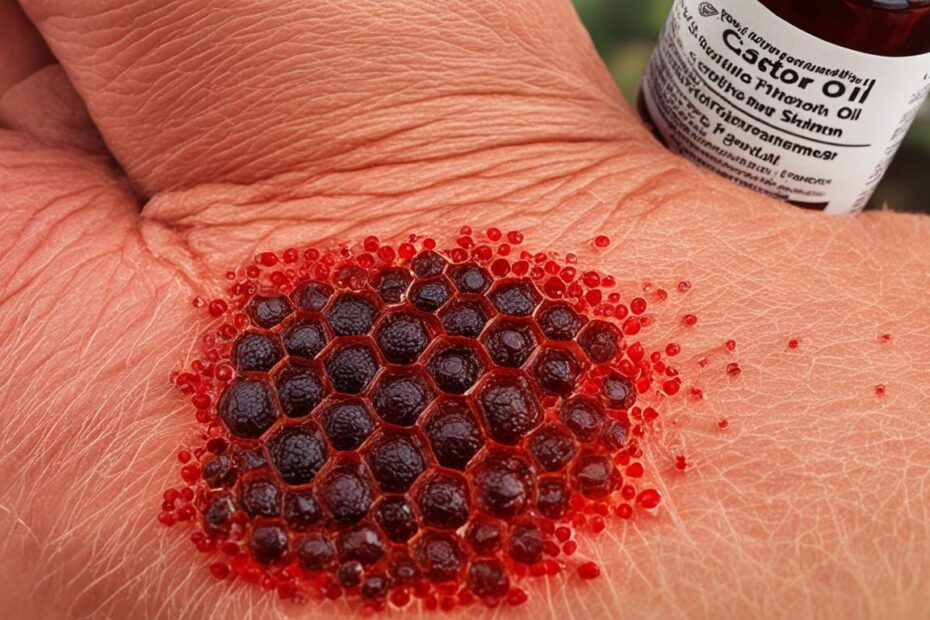Castor oil, derived from the seeds of the Ricinus communis plant, is a versatile vegetable oil that is commonly used for various purposes. Not only is it a popular laxative, but it is also used topically on the skin for its potential benefits. However, there have been reports of allergic reactions and contact dermatitis associated with the use of castor oil.
Some individuals may experience symptoms such as skin rash, swelling, itching, and irritation when exposed to castor oil. This suggests that castor oil can be allergenic for certain individuals. Allergic reactions to castor oil can be diagnosed through patch testing, which helps determine if a person is sensitive or allergic to castor oil.
Key Takeaways:
- Castor oil can cause allergic reactions and contact dermatitis in some individuals.
- Symptoms of castor oil allergy may include skin rash, swelling, itching, and irritation.
- It is important to perform patch testing to diagnose castor oil allergies.
- Individuals with known allergies or sensitivity to castor oil should avoid products containing this ingredient.
- Consult with a healthcare professional or dermatologist for personalized advice on managing castor oil sensitivity.
Benefits and Uses of Castor Oil for the Skin
Castor oil offers numerous benefits for the skin, making it a popular ingredient in skincare products. Its unique properties make it effective for various skincare concerns.
1. Acne Treatment
Castor oil’s antimicrobial and anti-inflammatory properties make it a potential remedy for acne. It can help reduce inflammation, redness, and swelling associated with acne breakouts, promoting a clearer complexion.
2. Moisturizing and Nourishing
Rich in fatty acids, castor oil can deeply moisturize and nourish the skin, making it an excellent choice for individuals with dry skin. It forms a protective barrier on the skin, preventing moisture loss and leaving the skin smooth and hydrated.
3. Anti-Inflammatory Benefits
Applying castor oil topically can help reduce inflammation in the skin. It can soothe irritated and inflamed skin conditions such as dermatitis and eczema, providing relief and supporting skin healing.
4. Improved Complexion and Even Skin Tone
Regular use of castor oil can promote the growth of healthy skin tissue, improving complexion and restoring uneven skin tones. It can help fade scars, blemishes, and age spots, giving the skin a more even and youthful appearance.
5. Safe for Sensitive Skin
Unlike some other oils, castor oil has a low comedogenic score, meaning it is unlikely to clog pores and cause breakouts. This makes it suitable for individuals with sensitive or acne-prone skin who are looking for a gentle and non-irritating skincare option.
6. Cleansing Properties
Castor oil’s triglycerides work effectively as a natural cleanser, removing dirt, impurities, and excess oil from the skin. It can be used as part of a cleansing routine to leave the skin clean, refreshed, and free from debris.
While castor oil offers several potential benefits for the skin, it is essential to note that individual experiences may vary. It is always recommended to patch test any new skincare product or ingredient before incorporating it into your routine.
How to Use Castor Oil on the Skin
When it comes to using castor oil on the skin, there are a few important steps to follow for optimal results and safety. Here are some key tips:
- Dilute the castor oil: To ensure better absorption and minimize any potential skin irritation, it is recommended to dilute castor oil with another carrier oil. Olive or peanut oil are commonly used for this purpose, and a recommended ratio is 1:1. This means that the quantity of castor oil should be equal to the amount of the other oil used.
- Decide on the application method: Depending on your preference and the area of the skin you want to treat, there are different ways to apply castor oil. For facial application, gently massage the diluted oil into the skin using circular motions. This can help improve blood circulation and promote better absorption. For the body, simply apply the diluted oil directly to dry skin areas and massage it in using gentle strokes.
- Allow for absorption: After applying the castor oil, it is recommended to leave it on for a few hours or overnight. This allows the oil to penetrate the skin, providing deep moisturization and nourishment. You may choose to cover the area with a clean cloth or plastic wrap to prevent transfer onto bedding.
It’s worth noting that the effectiveness of castor oil for specific skin conditions may vary. While it is generally well-tolerated, it is always a good idea to consult with a healthcare professional or dermatologist for personalized advice on using castor oil safely and effectively for your particular skin concerns.
Why Dilute Castor Oil?
“Diluting castor oil with another carrier oil, such as olive or peanut oil, helps promote better absorption and reduces the risk of skin irritation.”
Proper Application Technique
“Gently massage the diluted castor oil onto the skin using circular motions for facial application. For the body, apply the diluted oil directly to dry skin areas and massage it in using gentle strokes.”
| Step | Description |
|---|---|
| 1 | Dilute the castor oil with a carrier oil, such as olive or peanut oil, in a 1:1 ratio. |
| 2 | Gently massage the diluted castor oil onto the skin using circular motions for facial application. |
| 3 | Apply the diluted oil directly to dry skin areas on the body and massage it in using gentle strokes. |
| 4 | Leave the oil on for a few hours or overnight to allow for better absorption. |

Side Effects and Precautions of Using Castor Oil on the Skin
While castor oil is generally considered safe for topical use, it can cause side effects in some individuals. Allergic reactions, such as skin rashes, swelling, itching, and irritation, have been reported in certain cases. These reactions may be more common in individuals who are sensitive or allergic to castor oil.
It is important to discontinue use and seek medical attention if any adverse reactions occur. If you experience skin rashes, swelling, itching, or irritation after applying castor oil, it is recommended to stop using it immediately and consult a healthcare professional.
Performing a patch test before using castor oil on a larger area of the skin can help identify any potential sensitivity. To conduct a patch test, apply a small amount of diluted castor oil to a small area of your skin, such as the inner forearm, and wait for 24-48 hours. If you notice any signs of allergic reactions or skin irritation, like redness, itching, or swelling, avoid using castor oil on your skin.
Pregnant and breastfeeding individuals should also exercise caution when using castor oil topically. It is advisable to consult with a healthcare professional before incorporating castor oil into your skincare routine.
The Role of Research in Understanding Castor Oil Allergenicity
Despite the widespread use of castor oil, there is still limited scientific research on its allergenic potential and the dermatological benefits it offers. Most studies available are based on anecdotal reports and individual case studies rather than large-scale clinical trials.
Research on castor oil allergenicity is crucial in understanding the specific mechanisms that contribute to allergic reactions and skin sensitivities. Scientific studies on castor oil and skin reactions can provide valuable insights into the prevalence, severity, and long-term effects of allergic responses to this oil.
Clinical trials focused on castor oil sensitivity can help determine the optimal concentrations for patch testing and identify individuals at higher risk of experiencing adverse reactions. These trials can also shed light on potential mitigation techniques and strategies for managing castor oil sensitivity.
Dermatological research on castor oil can further explore the benefits and drawbacks of using this oil in skincare. By studying its effects on different skin types and conditions, researchers can develop evidence-based recommendations for safe and effective use.
A comprehensive understanding of castor oil and its effects on the skin will require further scientific investigation. Future research could explore the potential benefits of combining castor oil with other treatments for various skin conditions, further expanding its applications in dermatology.
Continued investigation through rigorous research methods is vital in establishing a deeper understanding of castor oil’s allergenicity, potential benefits, and possible adverse reactions. This knowledge can provide healthcare professionals, dermatologists, and consumers with evidence-based guidelines for safe and effective use of castor oil.

Conclusion:Is Castor Oil Allergenic
In conclusion, castor oil can potentially cause allergic reactions and contact dermatitis in certain individuals. It is crucial to be aware of the potential side effects and perform a patch test before applying castor oil to the skin. If any adverse reactions occur, it is recommended to discontinue use and seek medical attention.
While castor oil offers promising benefits for the skin, further research is needed to fully understand its dermatological effects and determine the optimal way to incorporate it into skincare routines. Consulting with a healthcare professional or dermatologist can provide personalized guidance on managing castor oil sensitivity and safely using it on the skin.
To help manage castor oil sensitivity and use it safely, here are some tips:
- Dilute castor oil with other oils for better absorption.
- Perform a patch test before applying castor oil to a larger area of the skin.
- Discontinue use if any adverse reactions occur and seek medical attention.
- Consult with a healthcare professional or dermatologist for personalized advice.
By following these tips and staying informed, individuals can make informed decisions about using castor oil and reduce the risk of allergic reactions or skin irritation.
FAQ
Is castor oil allergenic?
Castor oil has been associated with allergic reactions and contact dermatitis in some individuals.
What are the symptoms of castor oil allergy?
Symptoms of castor oil allergy may include skin rash, swelling, itching, and irritation.
How can castor oil allergy be diagnosed?
Castor oil allergy can be diagnosed through patch testing.
What are the side effects of using castor oil on the skin?
Side effects of castor oil on the skin may include allergic reactions, skin rashes, swelling, itching, and irritation.
What are the benefits of castor oil for the skin?
Castor oil has antimicrobial and anti-inflammatory properties, moisturizes and nourishes the skin, promotes healthy skin tissue growth, and helps cleanse the skin.
How should castor oil be used on the skin?
Castor oil should be diluted with other oils, such as olive or peanut oil, and gently massaged into the skin using circular motions.
What precautions should be taken when using castor oil on the skin?
It is important to perform a patch test, discontinue use if any adverse reactions occur, and consult with a healthcare professional before using castor oil topically during pregnancy or while breastfeeding.
What is the role of research in understanding castor oil allergenicity?
Research is needed to fully understand the allergenic potential of castor oil and its effects on the skin through scientific studies, clinical trials, and dermatological research.




